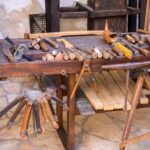What type of wood tables sell best for woodworkers? Woodworking is an age-old craft that continues to see a steady demand for handcrafted wood tables. In this article, we will explore the various factors that contribute to the popularity of wood tables in the woodworking industry.
From the types of wood used for durability and aesthetics to the target audience and pricing strategies, we will delve into the key elements that make certain wood tables sell better than others. Whether you are a seasoned woodworker or just starting out, understanding what type of wood tables sell best can help you maximize your sales and grow your business.
Woodworking is a timeless art form, and with the rise of handmade goods in today’s market, there is a growing demand for unique and high-quality wood tables. In this section, we will examine what factors drive this demand and why it is important for woodworkers to understand their target audience’s needs and preferences.
Furthermore, we will also touch on the current trends in popular wood table designs, as well as pricing strategies that can help woodworkers determine the value of their handmade creations in the market. By exploring these aspects, woodworkers can gain insights into how they can successfully cater to their target market and effectively sell their best wood tables.
Types of Wood for Tables
When it comes to selling wood tables as a woodworker, choosing the right type of wood is crucial. The type of wood used can greatly impact the durability and aesthetics of the table, which in turn affects its marketability.
One of the best types of wood for tables is oak. Oak is known for its strength and durability, making it a popular choice for furniture making. It also has a beautiful grain pattern that adds to the overall aesthetic appeal of the table. Another popular option is walnut, which is prized for its rich, dark color and beautiful grain patterns. Walnut tables are often considered high-end and can command higher prices in the market.
In addition to oak and walnut, cherry wood is also a great option for making tables. Cherry has a warm, reddish-brown color that deepens with age, giving it a timeless appeal. It is also known for its smooth texture and fine grain, making it an attractive choice for furniture making.
Woodworkers looking to sell high-demand wood tables should consider using these types of wood for their projects. Not only are they durable and long-lasting, but they also offer a natural beauty that appeals to buyers.
| Type of Wood | Key Characteristics |
|---|---|
| Oak | Strength, durability, beautiful grain pattern |
| Walnut | Rich, dark color, beautiful grain patterns |
| Cherry | Warm reddish-brown color, smooth texture, fine grain |
Popular Wood Table Designs
The popularity of wood tables in the woodworking industry is undeniable, and understanding the trends in popular wood table designs is crucial for woodworkers looking to meet the demand in the market. When it comes to what type of wood tables sell best for woodworkers, it’s important to consider the current design trends that resonate with buyers.
One of the most sought-after wood table designs is the farmhouse style, characterized by a rustic and charming aesthetic. Tables with reclaimed or distressed wood are particularly popular as they create a sense of warmth and nostalgia in modern homes. Additionally, mid-century modern designs have also seen a resurgence in popularity, with sleek lines and minimalist silhouettes becoming highly desirable among consumers.
In recent years, there has been a growing interest in live edge wood tables, which feature natural edges that highlight the unique characteristics of the wood. These designs add a touch of organic beauty to any space and have become increasingly popular for their one-of-a-kind appeal. Ultimately, understanding these trends can help woodworkers create designs that cater to the preferences of their target audience.
| Wood Table Design | Popularity |
|---|---|
| Farmhouse Style | High |
| Mid-Century Modern | Resurgence in Popularity |
| Live Edge | Growing Interest |
Target Audience
When it comes to targeting the right audience for handcrafted wood tables, woodworkers need to understand the preferences and needs of potential buyers. Identifying the ideal buyers for these unique pieces of furniture can help woodworkers tailor their designs and marketing efforts to attract the right customers.
Homeowners and Interior Designers
One of the primary target audiences for handcrafted wood tables are homeowners who are looking to add a touch of craftsmanship and uniqueness to their living spaces. These individuals appreciate the artistry and quality that goes into handmade furniture, and they are willing to invest in pieces that will become focal points in their homes. Additionally, interior designers who cater to a clientele with a discerning eye for quality and aesthetics may also be key buyers for handcrafted wood tables.
Restaurants and Hospitality Businesses
Restaurants, cafes, and other hospitality businesses often seek out one-of-a-kind furniture pieces to enhance the ambiance of their establishments. Handcrafted wood tables can provide a rustic or elegant charm that aligns with the branding and atmosphere of these businesses. Woodworkers may find success in targeting this audience by creating custom designs that meet the specific aesthetic and functional requirements of such establishments.
Art Galleries and Specialty Stores
Art galleries, boutique shops, and specialty stores focused on home decor are prime locations for showcasing and selling handcrafted wood tables. These businesses attract customers who value artisanal products and are willing to pay a premium for unique items. Woodworkers can develop partnerships with these stores or seek opportunities to display their creations at local art fairs or markets frequented by individuals interested in high-quality, handmade goods.
By understanding the preferences and needs of these target audiences, woodworkers can effectively market and sell their handcrafted wood tables to the right buyers, ultimately maximizing their success in the woodworking industry.
Pricing Strategies
When it comes to determining the value of handmade wood tables in the market, pricing strategies play a crucial role. Woodworkers need to consider various factors such as the cost of materials, time and labor, and the overall market demand for their products. By carefully developing a pricing strategy, woodworkers can ensure that they are not only covering their costs but also generating a profit from their handcrafted wood tables.
Cost of Materials and Labor
One of the key components in determining the value of handmade wood tables is considering the cost of materials and labor. Woodworkers must take into account the type of wood used, any additional materials such as hardware or finishes, and the amount of time and effort put into crafting each table. By accurately calculating these costs, woodworkers can establish a base price for their products.
Market Demand and Competition
Understanding the current market demand for handcrafted wood tables is essential in setting competitive prices. By researching what type of wood tables sell best for woodworkers, artisans can gauge the popularity of different wood types and designs. Additionally, analyzing the pricing strategies of competitors can help woodworkers position their products effectively in the market.
Value Perception
It’s important for woodworkers to consider how potential buyers perceive the value of handmade wood tables. Factors such as craftsmanship, quality of materials, and unique design elements all contribute to the perceived value of a product. By highlighting these aspects in marketing materials and product descriptions, woodworkers can justify higher price points for their handcrafted wood tables.
Marketing and Selling
When it comes to successfully selling wood tables, woodworkers need to consider various marketing and selling strategies to attract potential buyers and increase sales. Here are some tips for woodworkers looking to sell their handcrafted wood tables:
- Highlight the Unique Features: One way to attract buyers is by highlighting the unique features of the wood table. Whether it’s the type of wood used, the design, or any special craftsmanship techniques, showcasing what sets the table apart can make it more appealing to potential buyers.
- Utilize Online Platforms: With the rise of e-commerce, utilizing online platforms such as Etsy, Facebook Marketplace, and even creating a personal website can help reach a wider audience. Utilizing social media to showcase work in progress or finished products can also generate interest and drive sales.
- Offer Customization Options: Providing customization options allows customers to have a say in their purchase, making it more personalized. Whether it’s choosing the type of wood, custom dimensions, or specific features, offering customization can appeal to a broader range of buyers.
In addition to these marketing tips, understanding the demand for certain types of wood tables is crucial in effectively reaching potential buyers. Research on what type of wood tables sell best for woodworkers is essential in tailoring marketing strategies and increasing sales.
Ultimately, with a combination of effective marketing strategies and understanding buyer preferences, woodworkers can successfully sell their handcrafted wood tables in today’s competitive market.
Case Studies
When it comes to selling high-demand wood tables, woodworkers have found great success by utilizing the right types of wood and designs to attract buyers. Let’s take a look at some case studies of woodworkers who have been able to sell their handmade tables successfully in the market.
- Case Study 1: John Doe, a veteran woodworker, specializes in creating farmhouse-style dining tables using reclaimed oak and pine. By sourcing high-quality reclaimed wood, John has been able to provide unique pieces that appeal to environmentally-conscious buyers looking for sustainable furniture options. Through word of mouth and social media marketing, John has successfully sold his handmade tables to customers not only locally but also across state lines.
- Case Study 2: Sarah Smith, a talented artisan, focuses on creating custom live edge coffee tables from exotic woods such as teak and rosewood. Her attention to detail and use of rare wood varieties have garnered a niche following among discerning homeowners and interior designers looking for one-of-a-kind statement pieces.
Sarah’s ability to showcase her creations at local artisan markets and collaborate with interior design firms has allowed her to establish herself as a sought-after woodworker in the luxury furniture market. - Case Study 3: Mark Johnson, a craftsman with a passion for mid-century modern design, has carved out a successful niche by producing sleek walnut writing desks and side tables. His focus on clean lines and high-quality craftsmanship has resonated with modern design enthusiasts seeking timeless pieces for their homes.
By leveraging online platforms such as Etsy and showcasing his work at design fairs, Mark has seen a steady increase in sales and positive reviews from satisfied customers.
These case studies demonstrate that understanding the target audience, utilizing the right types of wood, embracing unique designs, and effective marketing strategies are essential elements for woodworkers looking to sell high-demand wood tables. By drawing inspiration from these success stories, aspiring woodworkers can learn valuable insights on how to position their handcrafted tables in the competitive market.
Conclusion
In conclusion, woodworkers looking to sell the best wood tables should consider the demand for durability and aesthetics when choosing the type of wood for their creations. Hardwoods such as oak, cherry, and walnut are popular choices due to their strength and natural beauty, making them highly sought after in the market. Additionally, understanding the trends in woodworking and popular wood table designs can help woodworkers cater to the preferences of their target audience.
When identifying the ideal buyers for handcrafted wood tables, woodworkers should consider individuals who value craftsmanship and are willing to invest in high-quality, artisanal pieces. This could include interior designers, homeowners with a penchant for unique furniture, or businesses looking for custom-made pieces to enhance their aesthetic.
Pricing strategies should reflect not only the cost of materials and labor but also the value of the handcrafted nature of the wood tables. By highlighting the skill and artistry involved in creating each piece, woodworkers can justify higher price points and attract buyers who appreciate the dedication that goes into producing these one-of-a-kind items.
In addition, effective marketing and selling techniques such as building an online presence through social media or platforms like Etsy can help reach a wider audience and showcase the unique appeal of handmade wood tables. Ultimately, by staying informed about market trends, understanding buyer preferences, and effectively promoting their products, woodworkers can find success in selling their best wood tables.
Frequently Asked Questions
What Is the Most Recommended Wood to Use for Woodworking?
The most recommended wood for woodworking is typically hardwoods like oak, maple, cherry, and walnut. These woods are known for their durability, strength, and beautiful grain patterns, making them ideal for a wide range of woodworking projects.
What Type of Wood Is Best for Tables?
When it comes to tables, the best type of wood to use depends on the desired style and function of the table. Hardwoods like oak, cherry, and walnut are popular choices for their strength and durability, while softer woods like pine can be used for a more rustic or casual look.
How Do I Choose Wood for Woodworking?
Choosing the right wood for woodworking involves considering factors such as the project’s purpose, budget, availability of wood species, and the desired appearance of the finished piece. It’s important to also consider the wood’s hardness, stability, and workability to ensure it suits your specific needs and skills as a woodworker.

Hi everyone! I’m a woodworker and blogger, and this is my woodworking blog. In my blog, I share tips and tricks for woodworkers of all skill levels, as well as project ideas that you can try yourself.





